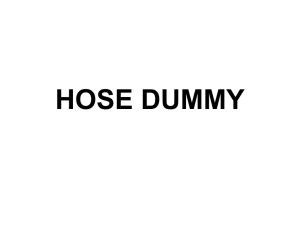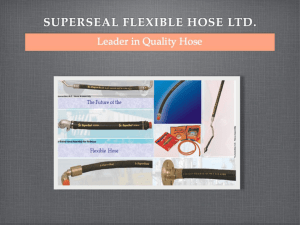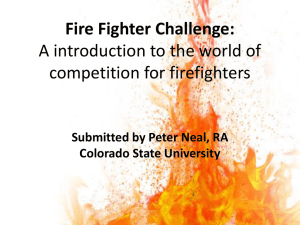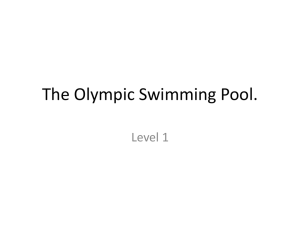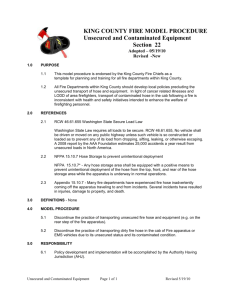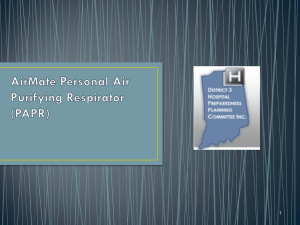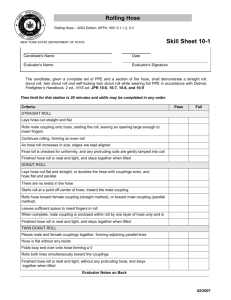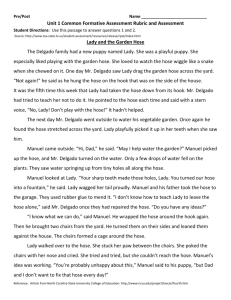Document
advertisement
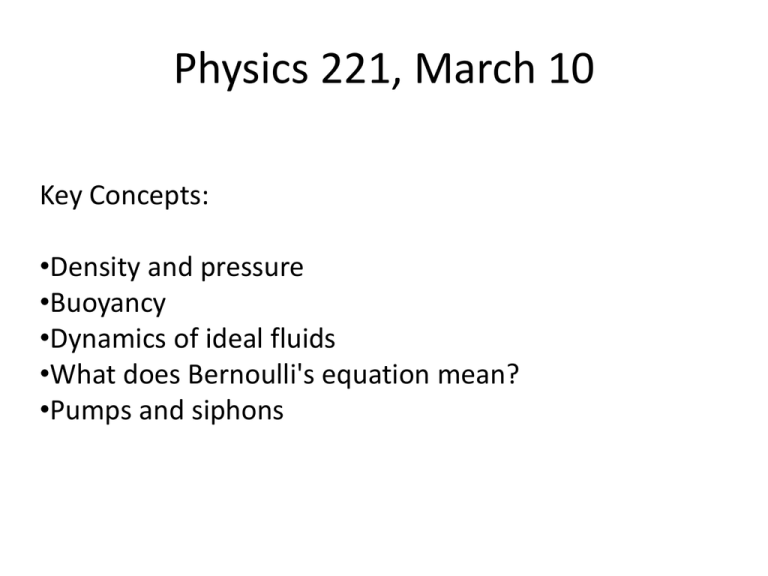
Physics 221, March 10 Key Concepts: •Density and pressure •Buoyancy •Dynamics of ideal fluids •What does Bernoulli's equation mean? •Pumps and siphons Definitions Fluids: Liquids Incompressible Gases Compressible Particle density: Density: Pressure: ρparticle = N/V ρ = M/V P = F/A Hydrostatics (liquids at rest): Pbottom - Ptop = ρgh Units: 1 atmosphere = 101 kPa = 14.7 pounds per square inch (psi) Note: ρwaterg(1m) = (1000kg/m3)*(10 m/s2)*(1 m) = 10 kPa Near the surface of the earth, the fluid at the bottom of a container is 1. under less pressure than the fluid on the top. 2. under more, less, or the same pressure as the fluid on the top, depending on the circumstances. 3. under more pressure than the fluid on the top. 0% 0% 0% 4. under the same 1 2 3 pressure as the fluid on the top. 0% 4 30 Buoyancy An object partially or wholly immersed in a gas or liquid is acted upon by an upward buoyant force B equal to the weight w of the gas or liquid it displaces. B=w Compare the densities of floating objects to the density of the liquid in which the objects are immersed. Will objects that float in water also float in methanol (density 790 kg/m3)? In saturated salt water (1200kg/m3)? Explain! Demonstration: http://www.phys.utk.edu/demoroom/FLUIDS/POLYDENSITY.htm Extra Credit: The density of freshwater is 1g/cm3 and the density of seawater is 1.03 g/cm3. A ship will float 1. at the same level in freshwater as in seawater. 2. higher in freshwater than in seawater. 3. higher, lower, or at the same level in freshwater as in seawater, depending on its shape. 4. lower in freshwater than in seawater. 0% 1 0% 2 0% 3 0% 4 30 You suspend a boulder weighing fifty pounds on a rope and lower it beneath the surface of the water in a lake. When the boulder is fully submerged, you find you have to support less than 50 pounds. As the boulder is submerged still further, the support force needed to hold the boulder is 1. more than just beneath the surface. 2. the same. 3. less than just beneath the surface. 0% 1 0% 0% 30 Extra Credit: A block of wood of uniform density floats so that exactly half of its volume is underwater. What is the density of the block? 1. 2. 3. 4. 0.5 kg/m3 500 kg/m3 1000 kg/m3 2000 kg/m3 0% 1 0% 2 0% 3 0% 4 30 A block of wood of uniform density floats so that exactly half of its volume is underwater. What is the density of the block? Floating no net force buoyant force = weight of object B = mobjectg = ρobject*Vobjectg But we also have: buoyant force B = weight w of the displaced water B = mdisplaced_waterg mdisplaced_water = = ρwater*½Vobject B = ρwater*½Vobjectg Setting the two expressions for B equal to each other: ρobject*Vobjectg = ρwater*½Vobjectg ρobject = ½ρwater Ideal Fluid Dynamics Ideal fluids Incompressible fluids flowing without friction equation of continuity: Bernoulli’s equation: (Area 1)*v1 = (Area 2)*v2 P1 + ρgh1 + ½ρv12 = P2 + ρgh2 + ½ρv22 Consequences: Hydrostatics: Pbottom = Ptop + ρg(htop - hbottom) Flow in horizontal pipe: P1 + ½ρv12 = P2 + ½ρv22 Extra Credit : The brake system in most cars makes use of a hydraulic system. This system consists of a fluid filled tube connected at each end to a piston. Assume that the piston attached to the brake pedal has a cross sectional area of one half a square inch and the piston attached to the brake pad has a cross section area of two square inches. When you apply a force of 10 pounds to the piston attached to the brake pedal, the force at the brake pad will be 1. 2. 3. 4. 5 pounds. 10 pounds. 20 pounds. 40 pounds. 0% 1 0% 2 0% 3 0% 4 30 Water is flowing smoothly through the pipe shown in the diagram. 1. 2. 3. 4. The pressure is lowest in section A. The pressure is lowest in section B. The pressure is lowest in section C. The pressure is the same everywhere. 0% 1 0% 0% 2 3 0% 30 4 A gardener is watering her garden from a hose. With the water pressure full blast holding the hose horizontally she can just reach a distance of 12 m, but needs to water an area up to 18 m away. By what fraction must she reduce the cross-sectional area of the hose, still keeping the hose horizontal, to be able to water this area? 1. 2. 3. 4. 5. ½ 1/3 2/3 1/6 ¼ 0% 1 0% 2 0% 3 0% 4 0% 30 5 A gardener is watering her garden from a hose. With the water pressure full blast holding the hose horizontally she can just reach a distance of 12 m, but needs to water an area up to 18 m away. By what fraction must she reduce the cross-sectional area of the hose, still keeping the hose horizontal, to be able to water this area? ∆y = (1/2)gt2 The time it takes the water to reach the ground depends only on the height of the outlet. ∆x = vt The horizontal distance traveled during this time Is proportional to v. A1v1 = A2v2 As the area of the outlet decreases, the water speed increases. A2 = A1v1/v2 = A1(12/18) = A1(2/3) The cross sectional area of the hose has to be reduced by 1/3. Water distribution The water level in the water tower changes very slowly, v1 ~ 0. P1 + ρgh1 + ½ρv12 = P2 + ρgh2 + ½ρv22 P1 + ρg∆h = P2 + ½ρv22 = constant more water usage higher water speed in the supply pipe lower water pressure for the user You are taking a shower in your dormitory when someone flushes a toilet nearby. The pressure in the cold water line drops and you find yourself showering in what feels like molten lava. This loss of cold water pressure occurs when the toilet lets cold water flow through the pipes delivering it to the bathroom and the water’s speed in those pipes increases. Assuming all the piping to be about on the same level, the cold water’s faster motion in the delivery pipes reduces its pressure in the shower head because faster moving water 1. 2. 3. 4. has less pressure than slower moving water. has less kinetic energy than slower moving water. has less gravitational potential energy than slower moving water. cannot carry deliver much volume. 30 0% 1 0% 2 0% 3 0% 4 Which one of the following is Bernoulli’s equation not involved in explaining? 1. 2. 3. 4. 5. Why a roof can blow off a house in a hurricane, the buoyant force on a floating iceberg, dynamic lift on airplane wings, how fast water sprays out from a hole in a water tank, it can explain all of these. 0% 1 0% 2 0% 3 0% 4 0% 5 30 Extra Credit: The lungs can exert a negative pressure, with respect to atmospheric pressure, of up to 1.3 kPa. To what height can you suck water through a straw? Remember: A 1 m high column of water exerts a pressure of 10 kPa. 1. 2. 3. 4. 13 cm 1.3 m 10 m 10 mm 0% 1 0% 0% 2 3 0% 4 30
